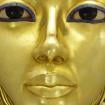
Bedazzling Treasures of Yuya and Tjuyu: Stunning Burial on a Par with Royalty – Part II
With their daughter, Tiye, married into the powerful ruling family of Egypt, Yuya and Tjuyu led a charmed life. With strong ties to their hometown Akhmin, Yuya seems to have participated actively in affairs of state – guiding the young Amenhotep III as he learned the ropes – with the consent of his purported sister, Mutemwiya. In admiration of the immense contributions of Yuya and Tjuyu, their grateful son-in-law prepared a sumptuously-stocked tomb in the sacred Valley of the Kings. However, grave robbers plundered KV46 on more than one occasion.

These superb, partially gilded and painted cedar shabtis of Yuya, father-in-law of Amenhotep III, were discovered during excavations by Quibell and Weigall in 1905. (Center) Shabti box of Yuya. Metropolitan Museum of Art, New York.
The Rich Contents of KV46
The tomb of Yuya and Tjuyu proved to be one of the few non-royal burials in the Kings’ Valley. A joint sepulcher, the funerary goods found here ranked among the most exquisite New Kingdom furniture; before Howard Carter’s spectacular discovery 17 years later – the tomb of Tutankhamun. Upon unwrapping the mummies, anatomist Grafton Elliot Smith declared that the remarkably well-preserved mummy of Yuya was one of the finest examples of the extraordinary embalming technique employed during the celebrated 18th Dynasty.

(Clockwise) The excellent state of preservation of the mummies of Yuya and Tjuyu bear testimony to the skill of 18th-Dynasty embalmers; an excavation assistant stands beside the 2.75 meter outermost coffin of Yuya shortly after its discovery (Public Domain); this, the most perfectly preserved and beautiful of the series of seven anthropoid coffins of Tuya, is, except for the eyes and the necklace, entirely covered in gold. Egyptian Museum, Cairo. (Photo: Heidi Kontkanen)
The massive 2.75 meters (9 feet) outermost coffin of Yuya was styled after the popular 18th- Dynasty ‘black’ coffers, which Dr Ikram and Dr Aidan Dodson state made its advent under Pharaoh Hatshepsut; gaining widespread acceptability all the way up to the reign of Ramesses the Great. Yuya’s anthropoid coffin is Osiride in appearance. The major parts of the body such as the hands, face, inscriptions, wig, and figures of protective deities are magnificently gilded; while the rest of the body is painted with black pitch, owing to the association of this color with fertility and rebirth
Like this Preview and want to read on? You can! JOIN US THERE ( with easy, instant access ) and see what you’re missing!! All Premium articles are available in full, with immediate access.
For the price of a cup of coffee, you get this and all the other great benefits at Ancient Origins Premium. And - each time you support AO Premium, you support independent thought and writing.
Independent researcher and playwright Anand Balaji is an Ancient Origins guest writer and author of Sands of Amarna: End of Akhenaten.
[The author thanks Heidi Kontkanen for granting permission to use her photographs. The public archives of the Metropolitan Museum of Art can be accessed here.]
Top Image: The richly decorated wooden chair or ‘throne’ of Princess Sitamun that was found in KV46; design by Anand Balaji (Photo credit: Heidi Kontkanen); Deriv.
By Anand Balaji















